- Joined
- 25 June 2009
- Messages
- 14,105
- Reaction score
- 4,214
Sergey Vladimirovich Ignatiev was born in 1955, and graduated from the Moscow Aviation Institute (MAI) with a degree in aircraft engineering in 1978. He joined EMZ-Myasishchev in 1980, first as a technician on the Myasishchev 3M bomber for two years, then as a designer: in the wing and tail department, in the design automation team, and finally as a design engineer of the 1st category in the general department.
On the side, Ignatiev started a series of personal designs under his own "Sigma" design bureau. The history of its development began with the design and manufacturing of the Sigma-1 aircraft, beginning in the summer of 1982. The aircraft was assembled on the sixth floor of a hostel, so the fuselage was made of two parts with a joint. In 1983, Gennady A. Baturin, a carpenter by profession, joined Ignatiev in the construction of the aircraft, and in 1986 test pilot Mikhail. Yu. Shevyakov completed the team. The name "Sigma" was formed from the first letters of the names of the participants in the construction: S-G-M.
The AS-1 "Sigma-1" was a single-seat braced high-wing aircraft of wooden structure with a pusher propeller. The single-spar wing used the GA(W)-1 profile, and was equipped with a slotted flap. The "Buran" provided about 32 hp, for speeds between 55 and 130 km/h. Empty weight was 142 kg. The first flight of the "Sigma-1" aircraft took place in May 1987, and it was introduced soon after that at SLA-87.
On the side, Ignatiev started a series of personal designs under his own "Sigma" design bureau. The history of its development began with the design and manufacturing of the Sigma-1 aircraft, beginning in the summer of 1982. The aircraft was assembled on the sixth floor of a hostel, so the fuselage was made of two parts with a joint. In 1983, Gennady A. Baturin, a carpenter by profession, joined Ignatiev in the construction of the aircraft, and in 1986 test pilot Mikhail. Yu. Shevyakov completed the team. The name "Sigma" was formed from the first letters of the names of the participants in the construction: S-G-M.
The AS-1 "Sigma-1" was a single-seat braced high-wing aircraft of wooden structure with a pusher propeller. The single-spar wing used the GA(W)-1 profile, and was equipped with a slotted flap. The "Buran" provided about 32 hp, for speeds between 55 and 130 km/h. Empty weight was 142 kg. The first flight of the "Sigma-1" aircraft took place in May 1987, and it was introduced soon after that at SLA-87.
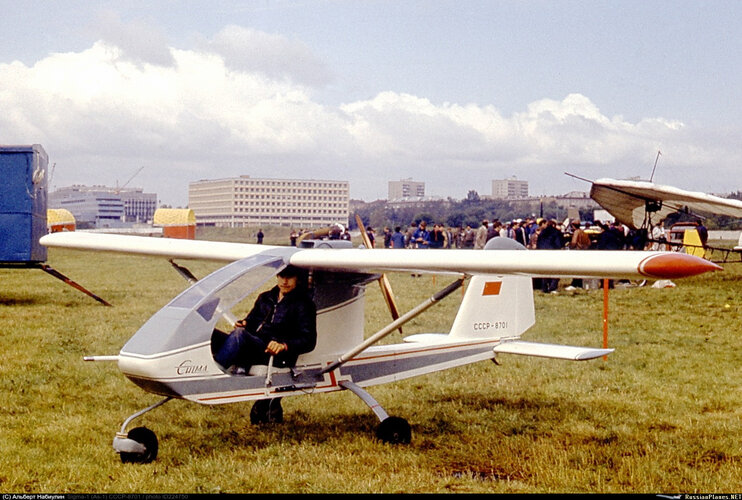
After being operated for about 5 years as a training aircraft, the "Sigma-1" was damaged during a forced landing on arable land due to an empty fuel tank, but it was possible to continue operating the aircraft after repairing the wing and installing the engine. The front end was reworked with a bubble-type windshield, which impaired the asthetics but provided a much better view for the pilot.
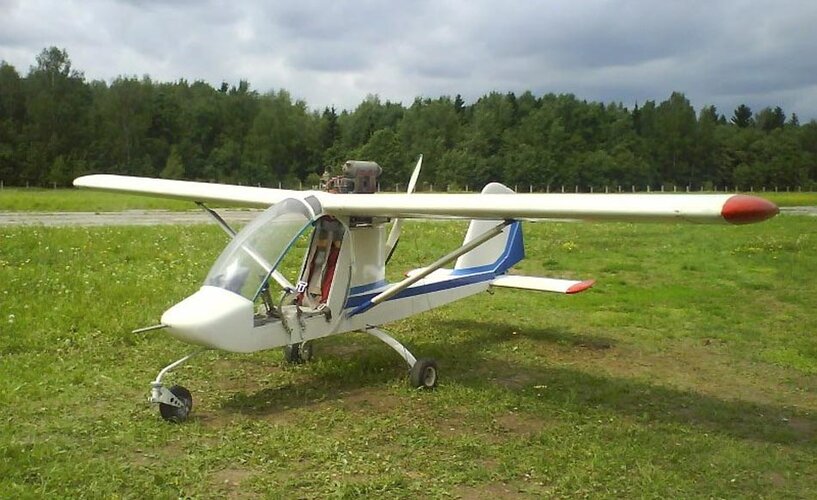
Above: The sole "Sigma-1" after its restoration, with the new "bubble"-type windshield.
Ignatiev decided to create a proper design bureau, KB Sigma, named after his first aircraft. He was joined by two new collaborators on this project: Mikhail Yurievich Shevyakov and M. M. Gromova. Shevyakov was born in 1956, a graduate from the Syzran VVAUL in 1977 who worked as an instructor at the same school until 1985. After graduating from the Test Pilot Training Center of the Air Force Research Institute in 1986, he worked at the Chkalov branch of that same Institute, and from 1990, as a test pilot there. Gromova was the test pilot and instructor on all Sigma aircraft. He was a qualified 1st class test pilot and had permission to perform international flights. He repeatedly performed flight work in Europe, Africa, the Middle East and Latin America.
The second Sigma design was the AS-2 "Sigma-2". It was initiated by Ignatiev in 1990. The aircraft had a modular layout with a forward overhead power plant. This scheme provided a good overview and ensured minimum alignment difference for various loading options. The layout features reduced the likelihood of damage to the propeller during off-airfield operation, especially when operating with a ski or float landing gear. The "Sigma-2" was easy to fly, and operation was accessible to the average person. Due to effecient aerodynamics, the take-off run length was reduced.

Organization and financing of the work on the AS-2 aircraft was carried out by ZAO Aviacomplex as of 1991, while production of three prototypes was carried out at the production base of EMZ-Myasishchev in Zhukovsky. Due to economic problems in 1994, however, Aviacomplex ceased operations. Since 1995, the second copy of the aircraft with a 36 hp Buran engine was used in the LII club named after. M.M.Gromova. After installing the 65 hp Rotax-582 engine, high flight performance characteristics were obtained, especially takeoff and landing characteristics were improved. The AS-2 aircraft towed a light glider with a climb rate of 2.5 m/s, performed route flights, and demonstrated high productivity in aerial chemical work in agriculture. It repeatedly participated in rallies and exhibitions, including MAKS-93, MAKS-97 and MAKS-99.
The second Sigma design was the AS-2 "Sigma-2". It was initiated by Ignatiev in 1990. The aircraft had a modular layout with a forward overhead power plant. This scheme provided a good overview and ensured minimum alignment difference for various loading options. The layout features reduced the likelihood of damage to the propeller during off-airfield operation, especially when operating with a ski or float landing gear. The "Sigma-2" was easy to fly, and operation was accessible to the average person. Due to effecient aerodynamics, the take-off run length was reduced.
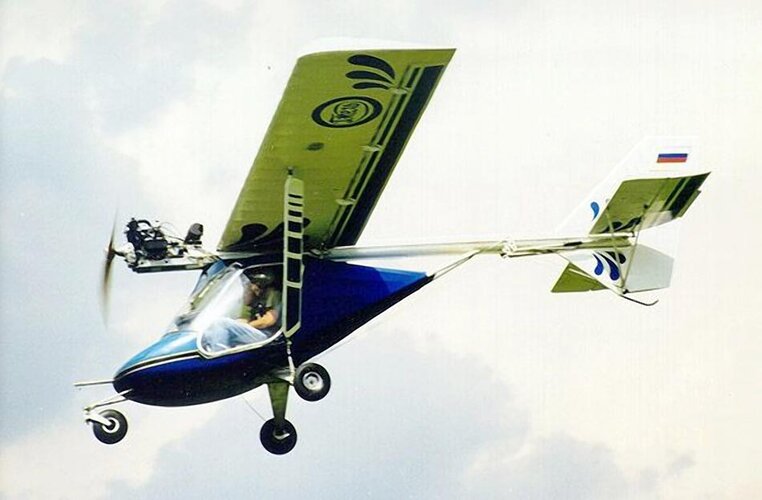
Organization and financing of the work on the AS-2 aircraft was carried out by ZAO Aviacomplex as of 1991, while production of three prototypes was carried out at the production base of EMZ-Myasishchev in Zhukovsky. Due to economic problems in 1994, however, Aviacomplex ceased operations. Since 1995, the second copy of the aircraft with a 36 hp Buran engine was used in the LII club named after. M.M.Gromova. After installing the 65 hp Rotax-582 engine, high flight performance characteristics were obtained, especially takeoff and landing characteristics were improved. The AS-2 aircraft towed a light glider with a climb rate of 2.5 m/s, performed route flights, and demonstrated high productivity in aerial chemical work in agriculture. It repeatedly participated in rallies and exhibitions, including MAKS-93, MAKS-97 and MAKS-99.
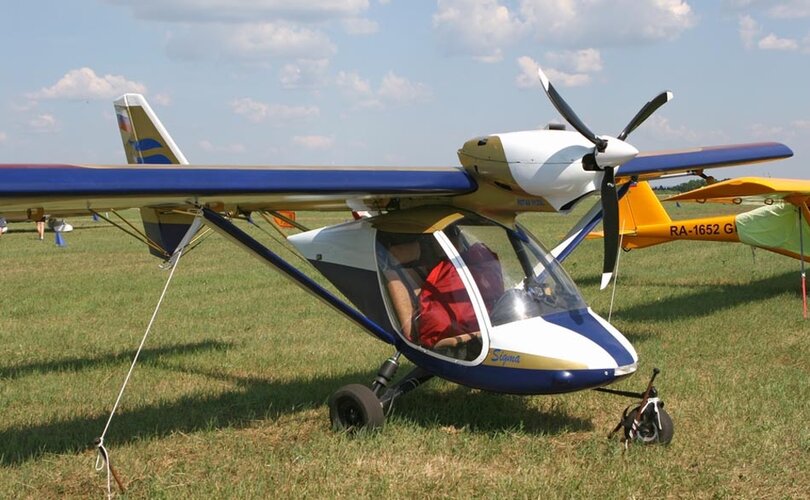
Above: Only three "Sigma-2" aircraft were built, but they laid the foundation for what would be the bureau's biggest success, the "Sigma-4".
Design of the AS-4 "Sigma-4" began in 1991. Compared to its predecessor, the "Sigma-4" had a distinct and original appearance. Its modular layout was evolved from the experience of previous projects. Thanks to the more powerful 100hp Rotax-912ULS, the payload weight was increased, the thrust-to-weight ratio and flight range were also increased, and flight performance was improved. The aircraft also boasted additional equipment: a rescue parachute system, side lights, headlights, skis, floats, and increasing comfort and electric flap release, as well as improved interior trim. The "Sigma-4" was intended for initial training, tourism, sports and active recreation. The large glazing surface provided almost all-round visibility, a convenient feature for aerial photography and patrolling. When equipped with a set of chemical attachments, the plane could also be used for agricultural work.
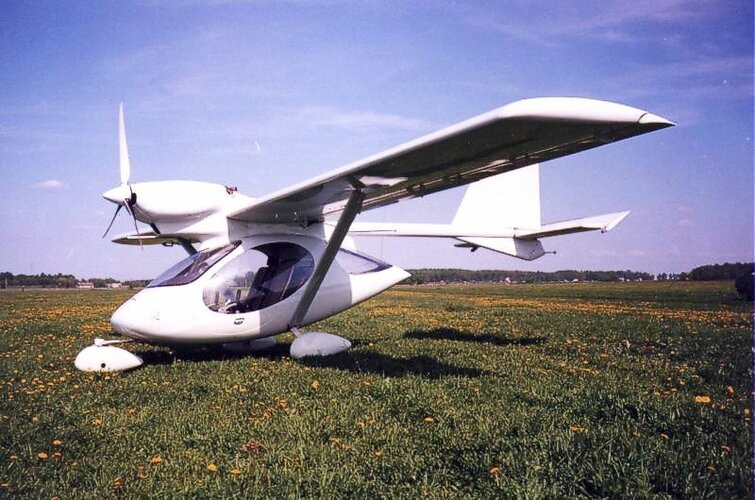
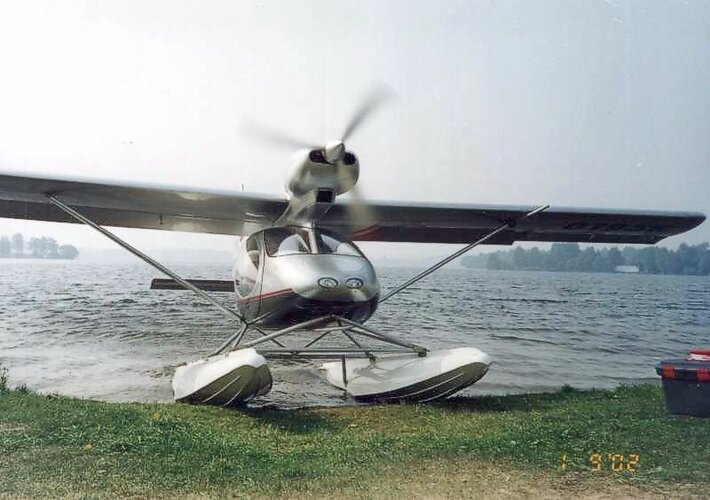
Above: The "Sigma-4" has been Ignatiev's most successful design so far.
The "Sigma-4" was produced by OOO Sigma starting in 1999. It was the company's biggest (and actually the only) commercial success. By 2004, nine examples had been built, but the type was also added to the line of the Elitar company in a slightly revised form as the "Elitar-Sigma", more of which were produced.
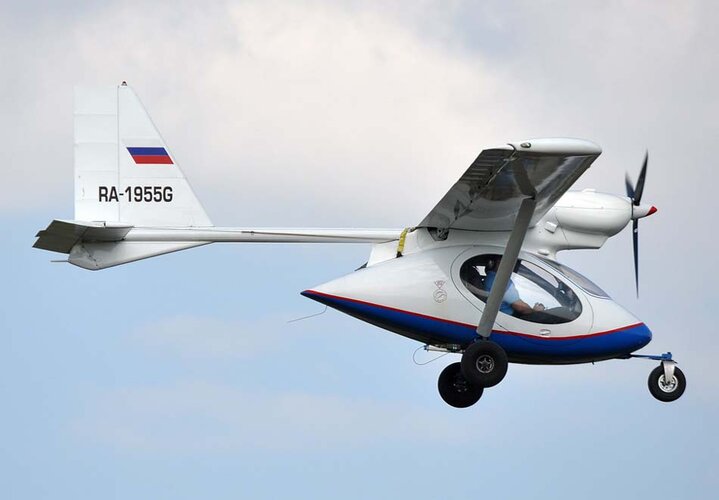
Above: The "Elitar-Sigma" can easily be recognized by the lack of rear windows.
 The "Akvarel" (Watercolor) was to be an amphibian derivative of the "Sigma-4" design. The fundamental difference was the layout of the cabin in the form of a three-seater boat with a retractable wheeled landing gear, while the pilot was located in front along the axis of symmetry of the aircraft, and the passengers were behind the pilot with the ability to stretch their legs to the side of him. This arrangement of the crew allowed for a dense but comfortable layout and a wide variety of options, including a sanitary one. Compared to the float version of "Sigma-4", the hull version would have provided significantly greater seaworthiness and better aerodynamics, with a positive effect on higher cruising speed and flight range. However, the "Akvarel" remained a project.
The "Akvarel" (Watercolor) was to be an amphibian derivative of the "Sigma-4" design. The fundamental difference was the layout of the cabin in the form of a three-seater boat with a retractable wheeled landing gear, while the pilot was located in front along the axis of symmetry of the aircraft, and the passengers were behind the pilot with the ability to stretch their legs to the side of him. This arrangement of the crew allowed for a dense but comfortable layout and a wide variety of options, including a sanitary one. Compared to the float version of "Sigma-4", the hull version would have provided significantly greater seaworthiness and better aerodynamics, with a positive effect on higher cruising speed and flight range. However, the "Akvarel" remained a project.The "Sigma-5" was a radical design departure from the previous models. Developed by the reorganized NPF Sigma-TS company, the aircraft was a twin-boom low-wing pusher with tricycle landing gear and a retractable nose wheel. The main landing gear had a lever design and was equipped with liquid-gas shock absorbers. The main wheels were equipped with hydraulically driven disc brakes. The wing center section and tail booms were made of metal. Fiberglass construction was used for the retractable slotted flap in the central part of the wing, the tapering of the wing and the retractable slotted flaps and ailerons. The wing panels and spar wall had a three-layer foam core construction.

Above: the sleek "Sigma-5" shows off its roomy cockpit and amazing unobstructed view.
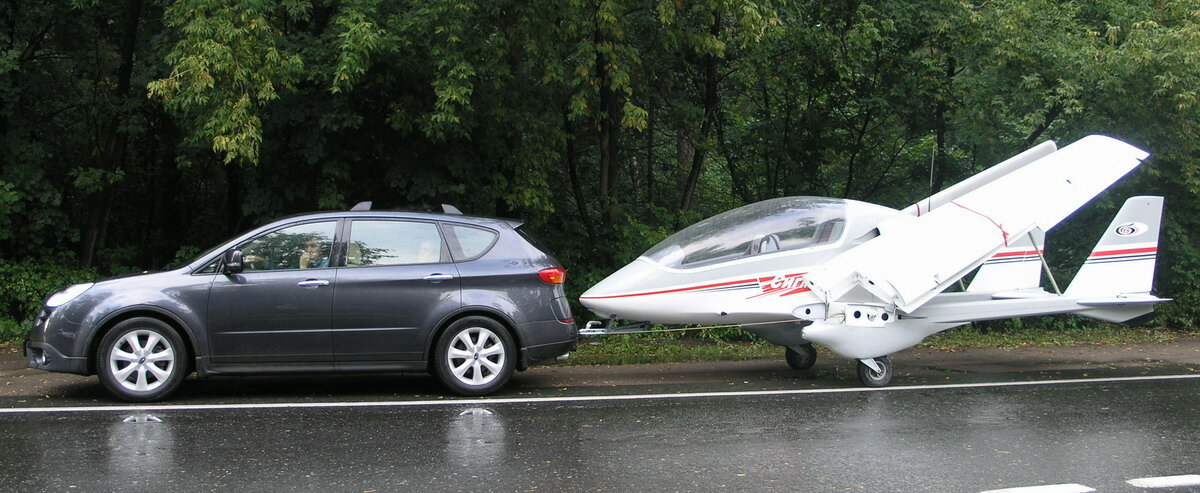
Above: An interesting feature of the "Sigma-5" was that it could be towed by a passenger car once its wings were retracted.
Despite its many interesting features and beautiful appearance, the aircraft did not attract any orders, and remained a sole prototype. True, it served as the basis for the "Luch", a tactical strike UAV entered by KB Luch in a Russian MoD R&D competition, but that was unsuccessful too. Experts believed that using a piloted aircraft as a UAV platform was not the best solution, and to make matters worse for Luch, its parent company, the Vega concern based in Rybinsk, was not held in very high regard in the MoD.
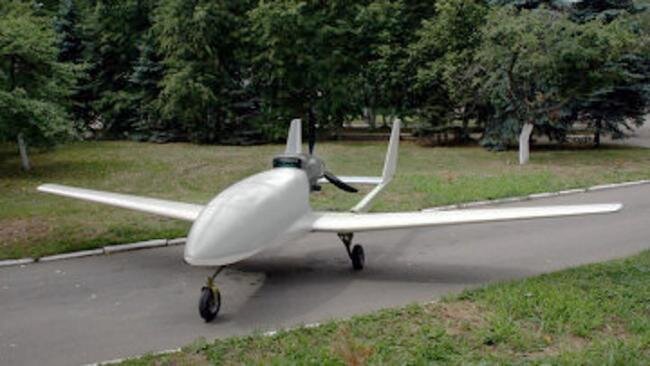
Above: The "Luch" UAV was an unsuccessful attempt at turning the "Sigma-5" into a strike UAV.
Displaying the innovative spirit of Sergey Ignatiev's design bureau, the "Sigma-6" is yet another radical design departure. It is a two-seat, strut-braced, high-wing light multi-purpose aircraft, with a tandem crew arrangement and a pusher propeller. First flown in 2016, the aircraft is equipped with a 100 hp Rotax-912S engine. A distinctive feature of the aircraft is the ability to quickly fold the wing according to the umbrella principle by moving the root parts of the wing consoles upward. This is done electrically in 15 seconds without the pilot leaving the cockpit and without the need to turn off the engine, that is, while on the move. Quick folding of the wing makes it easy to store and transport the aircraft, for example, from home to the outskirts of a populated area by towing behind a car or under its own power using a propeller.
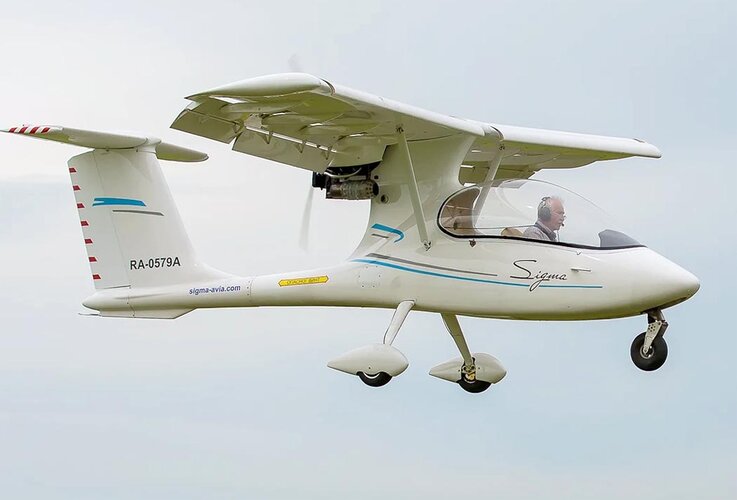
The second feature of the aircraft is the use of powerful wing mechanization, consisting of slats and retractable double-slot flaps, which provides a wide range of speeds and the possibility of off-airfield operation of the aircraft from small areas. The third feature is the front landing gear, which is retractable to half its diameter and has a quick-install towing device that allows the aircraft to be transported using a vehicle's tow bar. The aircraft has small dimensions, but a wide heated cabin with a dual control system. Take-off weight is 600 kg. It is planned to equip the aircraft with a ski or float amphibious landing gear as an option, while all maintenance or re-equipment of the aircraft can be performed by one person.
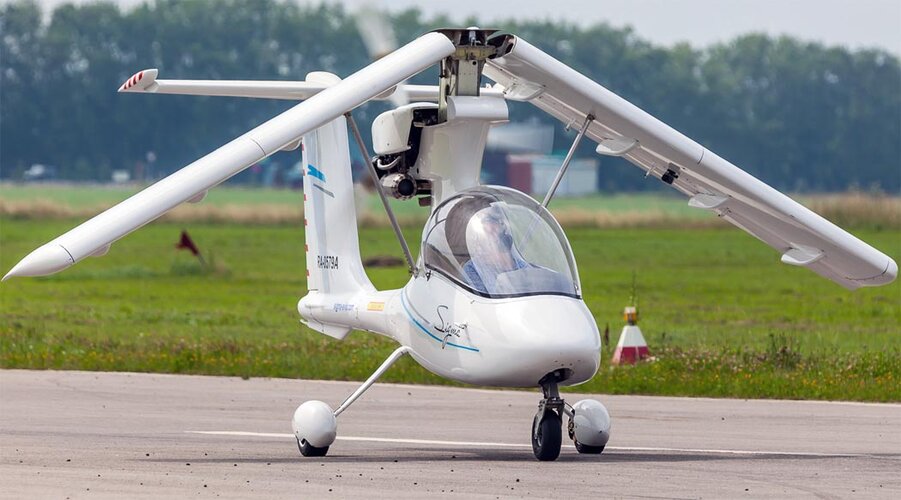
Above: The "Sigma-6" shown during the folding of its wings.
Latest Sigma offering is the "Sigma-7", a compact two-seater air vehicle that can be used as a car. The plane's wing folds and it can travel on the road at a speed of 60 km/h. According to test pilot Magomed Tolboyev, who christened the new aircraft "Mantis" (though the name is probably not be official), "The civil aircraft industry in Russia had reached a new level (...) Toyota is going to do it, America is going to do it, and we are doing it." Little is known about the new aircraft, but according to Tolboyev, “The wing opened, and immediately it took off. The lift-off speed is 50-80 km/h.”
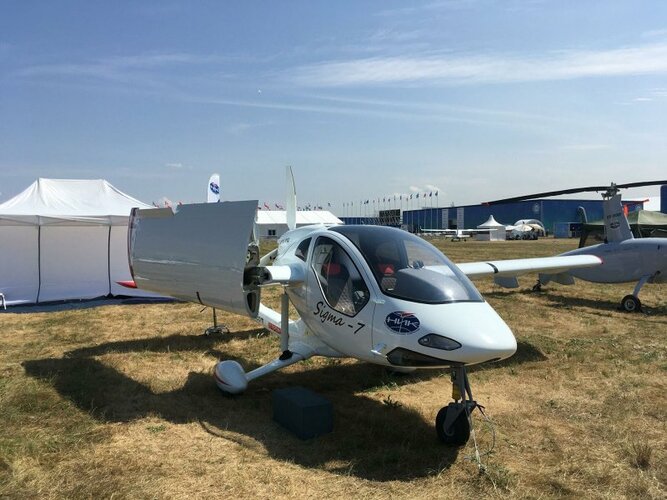
To conclude, I'd like to say a word about why I chose to talk about the Sigma line. First of all, I find the designs original and innovative. Also, apart from the "Sigma-4", they have all remained prototypes, and are seldom known outside of Russia, so I think they deserved to be tackled in the "Postwar Projects" section. I hope you have enjoyed them, and encourage you to find more photos about them (I have loads, but only selected a few here).
Research and article by Stéphane BEAUMORT
NOTE: I haven't gone through all the technical specifications for the Sigma aircraft, but if you're interested, they can be found online from several Russian-language sources:
Research and article by Stéphane BEAUMORT
NOTE: I haven't gone through all the technical specifications for the Sigma aircraft, but if you're interested, they can be found online from several Russian-language sources:
- Early "Sigma" designs: Flycenter.ru
- "Sigma-4": Flycenter.ru / Airwar.ru
- "Sigma-5": Airwar.ru
- "Sigma-6": Dzen.ru / Airwar.ru
Last edited:
